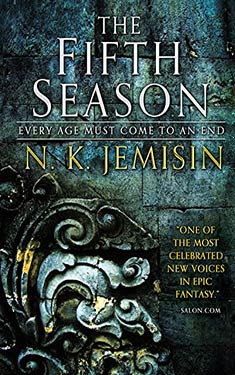N.K. Jemisin
Completed 10/15/2016 Reviewed 10/18/2016
4 stars
This book is a bit of a difficult read at first. There are three character narratives, one in
second person present, the other two in third person present. Each character is an orogene, someone who can
move or stay geophysical forces like earthquakes and volcanos. Through them, we learn what it is to be an
orogene in three different circumstances.
First, you are young and your gift (or curse) is first discovered, you
are taken to the Fulcrum, where you are assigned a Guardian who has often
abusive control over you. Second, you
are halfway through your orogene training in the controlled environment that is
none too pleasant. But now you’re
outside the Fulcrum on a journey and have to use your gift. Third, when you live with your gift hidden
from everyone, or as hidden as possible.
(Sorry, it’s quite by accident that I began writing in 2nd
person). None of these situations is
pleasant. It turns out being an orogene
isn’t pleasant.
This is magnificent world building. It’s incredibly imaginative, a world where
the magic is in control of the earth.
It’s a little like being an earth bender from the cartoon Avatar: The
Last Air Bender. But here it’s all
about the earth. “Earth” is used like we
use “Hell”, and “rust” is a curse. The
continent is called The Stillness, but it is anything but still. Hence the need for orogenes to keep the
ground from shaking. But the world is
afraid of the orogenes for the potential destruction they can cause as
well. So they are rounded up and taken
to the Fulcrum, a sort of school where they are watched by their sadistic
guardians and trained in their gift.
As you can see, the world is very dark, but not dark in a
typical middle-ages pseudo-European world.
People are light and dark skinned, male and female, and not exclusively
heterosexual. It makes for a really
well-rounded world. I have to say I
occasionally had a hard time remembering who was what race, which I think
speaks to how much I am conditioned to thinking that the characters of a story
are always default white.
The prose is also amazing.
I have to admit, 2nd person is not my favorite tense to read,
but those chapters read more easily than I expected. I think it speaks well to Jemisin as a
writer. I had a much tougher time
reading “Halting State” by Charles Stross, which was also written in 2nd
person. Here the narrative flows much better, though
it still took me several chapters to get into the swing of the tense. Especially since it alternates with chapters
written in 3rd person present.
The one thing I didn’t find was empathy for the
characters. I was really interested in
what was happening to them, but I wasn’t right there with them. I never completely immersed myself into the
story. I found this sad because I was
all ready to jump on the five star bandwagon that this book has been
riding. Maybe I’m still in a place where
I can’t let myself go completely when I’m reading. I found myself a little distanced from it, able
to observe that this was an intense, well-crafted book, but not able to feel
it. So I give this book four stars out
of five.
As a sort of post script, I want to add that the reader
should be aware of the glossary at the back of the book. It really helps with understanding the
universe of the book. I didn’t discover
the glossary until about halfway through the book. Finding it made a bit difference.

No comments:
Post a Comment